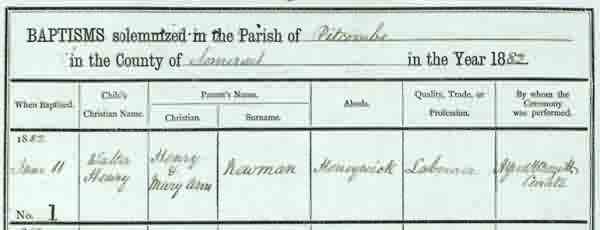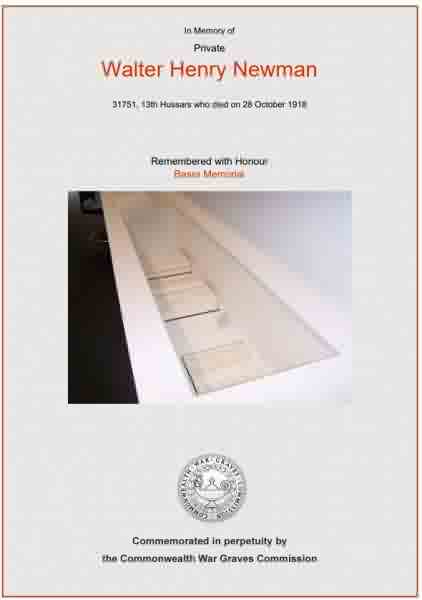yeovil at War
Walter Henry Newman
Drowned while crossing the River Tigris
Walter Henry Newman was born in 1882 at Honeywick, Hadspen, Somerset and baptised at Pitcombe on 11 June 1882. He was the son of agricultural labourer Henry Newman (b1855) and Mary Ann née Keylock (b1854). In the 1891 census Henry and Mary were listed at Arthur's Bridge Farm, Lamyatt, Shepton Mallet, Somerset. They were to have seventeen children: Louisa (b1874), Sarah (b1877), Jane (b1878), George (b1882), Walter, William (b1886), Bessie (b1886), Emmeline (b1888), Edith (b1888), Rose (b1889), Rosina (1890-1935), Fred Wall (b1891), Gerty (b1892), Mary Wall (b1893), Julia (b1895), Elfrida (b1895) and Arthur (1895-1974).
 It
is not known
when Walter
enlisted, but by
the time of his
marriage (on 21
December 1903 at
St John's church
to Kate Abbot),
he was already a
Private in the
13th Hussars. In
the marriage
register both
Walter and Kate
gave their
address as 11
Silver Street.
It appears that
after their
marriage they
lived in
Cecil Street.
It
is not known
when Walter
enlisted, but by
the time of his
marriage (on 21
December 1903 at
St John's church
to Kate Abbot),
he was already a
Private in the
13th Hussars. In
the marriage
register both
Walter and Kate
gave their
address as 11
Silver Street.
It appears that
after their
marriage they
lived in
Cecil Street.
It is assumed that Walter had left the army by the outbreak of war and was therefore on the Reserve List. The 13th Hussars was based in Meerut in India at the start of the war and landed in Marseille as part of the 7th (Meerut) Cavalry Brigade in the 2nd Indian Cavalry Division in December 1914 for action on the Western Front. It is thought that Walter, as a Reservist, may have re-joined his regiment in France after brief refresher training in England.
The 13th Hussars then moved to Mesopotamia, still part of 7th (Meerut) Cavalry Brigade, in July 1916. The regiment took part in the Second Battle of Kut in February 1917, the capture of Baghdad in March 1917 and the Battle of Sharqat in October 1918.
The Second Battle of Kut was fought on 23 February 1917, between British and Ottoman forces at Kut, Mesopotamia (present-day Iraq). The battle was part of the British advance to Baghdad begun in December 1916 by a 50,000-man British force (mainly from British India) organised in two army corps. The British, led by Frederick Stanley Maude, recaptured the city, but the Ottoman garrison there did not get trapped inside since the Ottoman commander, Kâzım Karabekir Bey, managed a good-order retreat from the town of his remaining soldiers (about 2,500), pursued by a British fluvial flotilla along the Tigris River. The British advance wore off on 27 February at Aziziyeh, some 60 miles (100 km) beyond Kut. After three days' worth of supplies had been accumulated, Maude continued his march toward Baghdad.
The British launched their new campaign on 13 December 1916. The British had some 50,000 well-trained and well-equipped troops: mostly British India troops of the Indian Expeditionary Force D together with the 13th (Western) Division of the British Army forming the Mesopotamia Expeditionary Force. The Indian divisions of the Indian III Corps (also called the Tigris Corps) included British Army units. The Ottoman forces were smaller, perhaps around 25,000 strong under the overall command of General Khalil Pasha.
The march on Baghdad resumed on 5 March 1917. Three days later, Maude's corps reached the Diyala River on the outskirts of the city. Khalil Pasha chose to defend Baghdad at the confluence of the Diyala and the Tigris, some 35 miles south of Baghdad. The Ottoman troops resisted the initial British assault on 9 March. General Maude then shifted the majority of his army north. He believed that he could outflank the Ottoman positions and strike directly for Baghdad. Khalil Pasha responded by shifting his army out of its defensive positions to mirror the move of the British on the other side of the river. A single regiment was left to hold the original Diyala River defences. The British crushed this regiment with a sudden assault on 10 March 1917. This sudden defeat unnerved Khalil Pasha and he ordered his army to retreat north to Baghdad.
The Ottoman authorities ordered the evacuation of Baghdad at 8pm on 10 March, but the situation was rapidly moving beyond Khalil Pasha's control. The British followed close on the heels of the Ottoman troops and captured Baghdad without a fight on 11 March. A week later, General Maude issued the Proclamation of Baghdad. Some 9,000 Ottoman troops were caught in the confusion and became prisoners of the British.
The Battle of Sharqat (23-30 October 1918) was fought between the British and the Ottoman Empire in the Mesopotamian Campaign. This became the last conflict in the between the belligerents before of the signing of the Armistice of Mudros.
Anticipating an Ottoman armistice following the defeat of the Ottomans in Palestine and the recent surrender of Bulgaria, British Premier David Lloyd George ordered Sir William Marshall, Commander-in-Chief on the Mesopotamian front, to remove any residual Ottoman presence from that theater by twin advances up the Euphrates and Tigris rivers, and capture the oil fields near Mosul on the Tigris. There was a lack of available transport, after a large amount had been supplied to Dunsterforce for its advance across Persia, so Marshall persuaded the government to limit the advance to the Tigris Front only.
An Anglo-Indian force consisting of the 17th and 18th Indian Divisions and the 7th and 11th Indian Cavalry Brigades, led by Sir Alexander Cobbe, left Baghdad on October 23, 1918. In just 39 hours they covered 75 miles (120 km) to the Little Zab River, where the 'Dicle Group' of the Ottoman Sixth Army, led by İsmail Hakkı Bey, who was the commander of the Ottoman 14th Division, was awaiting them. The Sixth Army had been weakened due to lack of replacements. His forces consisted of the XVIII Corps, which comprised the 14th and 46th Divisions, and the XIII Corps, which comprised the 2nd and 6th Divisions.
Seeing his army's rear threatened, İsmail Hakkı Bey withdrew another 60 miles (100 km) to the north to Sharqat, where Cobbe attacked him on October 29, sending the 11th Cavalry Brigade to pin the Ottoman front while the 17th Division came up to support them. The 17th were delayed in arriving, and the cavalry were shelled by Ottoman guns overnight. In the morning the 13th Hussars charged the hill where the guns were, and made a dismounted charge up it with fixed bayonets, successfully capturing the guns. İsmail Hakkı Bey was aware of the peace talks at Mudros, and decided to spare his men rather than fight or break out. He surrendered on October 30. The 18th Division advanced on Mosul, 50 miles further north, and were 12 miles short of the town when the armistice was declared.
In a letter to Sir RS Baden-Powell from Colonel Richardson dated 4 November 1918 describing the Battle of Sharqat on 28-29 October, recorded "Private Harvey was wounded by shellfire at the ford early in the morning, and the following were drowned whilst crossing the river on the previous evening viz., Lance-Corporal Bartlett, Privates Newman and Donoghue." Walter was aged 36.
The Western Gazette, in its edition of 15 November 1918 recorded "Mrs W Newman, of 3 Cecil Street, has received an official notification that her husband is presumed to have drowned on October 28th whilst on homeward journey from Mesopotamia."
The 13 December 1918 edition of the Western Gazette reported "Mrs W Newman, of 3 Cecil Street, has received a notification from the War Office, confirming the official report she recently received to the effect that her husband Private Walter Newman, was drowned on his way home from Mesopotamia, and that his body has been recovered from the Tigris. Mrs Newman has also received a Royal message of sympathy."
Walter's name was recorded on the now-destroyed Basra Memorial and his name is recorded on the War Memorial in the Borough.
gallery

Walter's baptism
entry in the
Pitcombe parish
register.

Walter and
Kate's marriage
recorded in St
John's parish
register. Note
that, even at
this time,
Walter was a
Private in the
13th Hussars.

The Commonwealth War Graves Commission certificate commemorating Walter Newman.